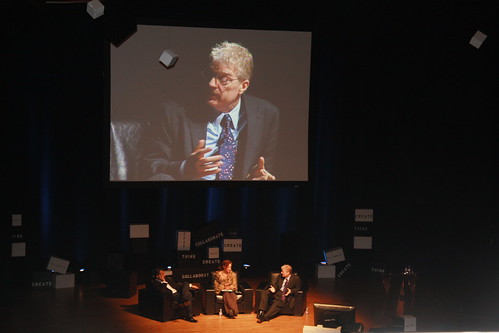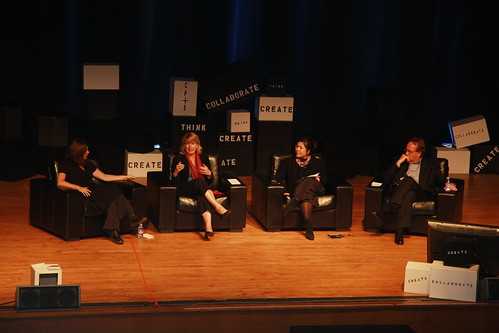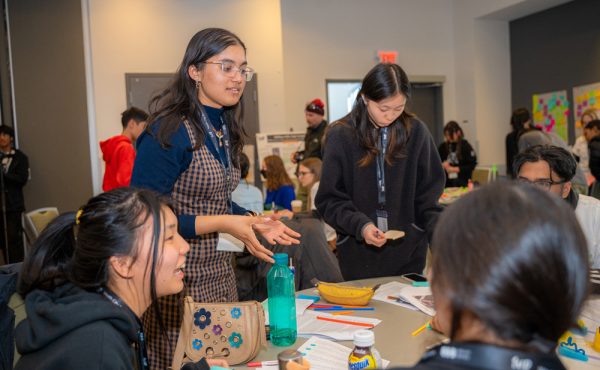
The Creative Places and Spaces: Collaborative City Conference started with a bang…or rather an om! As delegates filled the round tables in the beautiful Carlu Concert Hall, the stage was filled with lithe, lean bodies, contorting themselves into planks, trees and warriors. Along with rhythmic music and singing, the yoga enthusiasts were soon surrounded by break dancers, tap dancers and an acrobat hanging upside down from a rope. No, we are not at a Cirque du Soleil rehearsal, but rather one of the world’s leading dialogues on creativity.
This year’s conference has the theme of the Collaborative City and promises to be a thought-provoking and inspiring few days. As Matt Galloway, host of CBC Radio One 99.1 FM’s “Here and Now” and the MC for the morning session stated, we are going to “hear a lot about how ideas and collaboration can inspire change. Leadership is going to play a large part in that dialogue.” On that note, he introduced Mayor David Miller, to give the first welcoming remarks of the day. Miller spoke about the need to collaborate not only within our own city, but also between cities, with the example of Toronto’s twinning with Frankfurt and their current project to collaborate in the film and television industry. Miller also touched on the idea of asking the experts to help write and develop reports and strategies, rather then asking for their opinions after the fact, which he says they did with Toronto’s Agenda for Prosperity, noting it was unanimously passed by Council, a rare thing for the City of Toronto. Tim Jones, CEO of Artscape, the organizers, said, quite pertinently, “we have a lot to learn from one another…there are tools and there are methodologies, but most important, we need to raise our game as a city.”

Sir Ken Robinson, the morning’s first keynote speaker, inspired the crowd to their feet with his words on creativity and imagination. He spoke about the unrecognized creativity in all of us and our capacity, as humans, “to stand outside our current situation and bring to mind alternatives…[that] can have a future one can speculate about.” Robinson claimed you cannot start with innovation, but rather you must first “cultivate your imagination [and] creativity is a step on from imagination.” He defined creativity as “the process of having original ideas that have value” and that “being creative means challenging things we take for granted.” He discussed the importance of divergent thinking, stating, “if you’re stuck on a question, ask a different one.”
Scattered throughout the speakers were short Video Spotlights, and the first was by Eleni Arbus, an independent filmmaker, who produced The Melbourne Laneways. The Australian city has had somewhat of a revitalization recently of its narrow laneways, which cut through the city, like many of Europe’s Old Towns. These changes have occurred despite there being no overall program or strategy that targeted these small streets. Instead, it came from a collaboration between local artists, business owners, and architects. According to Rob Adams, Director City Design and Urban Environment for the City of Melbourne, an incentive program has now been set up to promote businesses and residents to inhabit and make changes to these areas. As the video makes clear, it was a series of small changes in policy that allowed these areas to develop, not one single project. As Andy Mac, a local graffiti artist whose art adorns most of the laneways says, “you have to grow these cultures, they come from a general grassroots thing…people need to feel like they can play and invent.”
Up next, Richard Florida, the second keynote speaker, gave praise to Mayor David Miller saying, “when all is said and done, he will be seen as one of the most transformational figures in the modern history of Toronto, steering this city from where it was…to where it needs to go, which was no easy task.” Discussing his new book, with the tentative title The Great Reset: How the economic crisis will reshape the way we work, our cities and the way we live, Florida spoke about the major crises throughout our history and how these moments in time shaped our societies and created periods of great innovation. “Each of these periods has tapped into a new reservoir of human creativity,” Florida said, adding that at the first CPandS conference, Jane Jacobs told him that, in relation to squashed creativity, “it is the squelchers that are the problem, those squelchers are not just people, they are institutions.”
During the Town Hall Panel discussion, moderated by Sara Diamond, President of Ontario College of Art and Design, Robinson stated that the “role of a great creative leader is not to have all the great ideas, but to create the conditions for great ideas, ” while Florida responded by saying, “a city that works is one that activates intuitions.” Speaking about the problem of simply piling on more layers of government in order to make change happen, Florida said we should rather pull out the layers that don’t work and make communities and neighbourhoods stronger with more self-government, stating, “government is best done locally in a distributed fashion.”

Katerina Cizek, Filmmaker-in-Residence at St. Michael’s Hospital, spoke with Gerry Flahive, Senior Producer, National Film Board, Dr. Katherine Rouleau, Assistant Professor at St. Michael’s Hospital and Ana Serrano, Director, Canadian Film Centre New Media Lab about raising awareness of health issues in Canada through a collaboration between filmmakers and health professionals. She touched on the importance of these Video Bridges to talk to those wanting to create a dialogue, but who aren’t necessarily those that can make change happen. The National Film Board announced during this session a new global project called High Rise, which will look at 10 towers in 10 suburbs in 10 growing cities around the world. Using local community members to create the multi-media project, it will ask how documentary film can help reinvent our cities, both community based and universal, local and global.
Tom Wujec, of Autodesk, bestowed the virtues of collaboration and creativity in the business sector, about the ability of rendering products (such as Autodesk) to visualize the future. But if the future and the results of collaboration are unforeseeable, as both Robinson and Florida touched upon in their talks, how are these ideas transferable to non-market driven collaboration? Wujec encouraged three key ideas for collaborating: bring the Chief Design Officer to the table; foster a community that values design and authentically embrace design. What can apply from Wujec’s thoughts is bringing holistic thinking to the idea of the collaborative city.
In the final session, Aled Edwards, Chief Executive of the Structural Genomics Consortium, Pekka Sinervo, Senior V.P. Research, Canadian Institute for Advanced Research and Ilse Treurnicht, CEO of MaRS discussed the challenges and benefits of open-access collaboration in sciences. They spoke about the “need to learn how to fail in the open,” as Edwards explained. One of the most important questions they raised was whether these projects would have worked as well, or better, without collaboration, to which Edwards responded with, “collaborating willy-nilly didn’t work, you had to know the person,” learning the value and importance of personal connections. As Sinervo points out, “good collaboration works because there is trust, there is respect, there is good collegiality.”
Some interesting ideas and questions were raised throughout the day, but the most important challenge is how to move from dialogue to action. But as one tweeter commented, “Choir, meet Preacher”, we all know collaboration is good (for the most part), but many organizations and individuals don’t know how to get the ball rolling, and as was made clear today, you need to be specific with the who’s and why’s of a collaborative partnership.
So…stay tuned for Day Two, which will include highlights from Luigi Ferrara, Director of School of Design at George Brown College, Lyn Heward, Consultant and Executive Producer for Cirque du Soleil, Charles Landry, Author, Urban Thinker and Founder of Comedia and many others.
Photos by Artscape Toronto and Nicole Bruun-Meyer



6 comments
I was really saddened this conference was during weekdays, in the middle of the day. I work 9-5 and couldn’t come out to any of these talks.
Is there anywhere where I can listen to them online?
Check their website — there is stuff up I believe..
Having outsiders prepare reports should be mandatory. Quite honestly, many staff reports are of dubious quality. I would go so far as to say, many are political instruments rather than honest evaluations.
Thanks Shawn. I’ll keep checkin’ back to see if they post some video’s up from thursday and today(friday)
I’d most like to hear Charles Landry. He’s the least “in your face” of the Florida/Robinson/Landry triangle.
I led a walk around downtown on Wed with Landry — he’s a good guy, no doubt.
[…] Spaces conference last week. Also this mention in Now Magazine, this notice in blogTO and this synopsis at […]